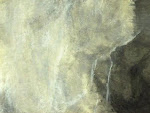-------------------------------------
How to draw ink paintings, 1: Footnote (digital references)
1) Sha Kaku | しゃかく | Xie He 〔謝赫〕(? - ?).
Art historian and Critic of the Southern Qi (479-502). He wrote “The Record of the Classification of Old Painters (『古畫品錄』, Guhua Pinlu)” https://en.wikipedia.org/wiki/Xie_He_(artist)
2) Koga Hinroku | Guhua Pinlu | 『古画品録』 / Xie He〔謝赫〕 Full text Wikibooks: 全文;維基文庫 https://zh.wikisource.org/wiki/%E5%8F%A4%E7%95%AB%E5%93%81%E9%8C%84 .
He wrote: 「1,Spirit Resonance氣韻生動是也;2,Bone Method骨法用筆是也;3,Correspondence to the Object應物象形是也;4,How to color suitability to Type隨類賦彩是也;5,Division and Planning or design經營位置是也;6,Transmission by Copying傳移模寫是也」.
Kinbara, Shōgo 〔金原省吾〕wrote: 『Shina jōdai garon kenkyu: Research of old Chinese paintings | 支那上代画論研究』http://dl.ndl.go.jp/info:ndljp/pid/1870017/107? .
The book has the following commentary. A comparison study between "Koga Hinroku 『古画品録』" and "Rekidai Meigaki 『歴代名画記』" and " Six principles of Chinese painting 「画の六法」" are described.
3) Chō Gen’en | ちょう, げんえん | Zhang Yanyuan 〔張彦遠〕(811? – 877?)
4) Rekidai meigaki | Lidai minghuaji 『歴代名画記 巻一』 “Commentary on famous masterpieces of China”/ 〔張彦遠〕撰 Full text:全文:維基文庫. https://zh.wikisource.org/wiki/歷代名畫記/卷第一
“Six principles of Chinese painting” as follows: 「彥遠試論之曰:古之畫,或能移其形似,而尚其骨氣,以形似之外求其畫,此難可與俗人道也. 今之畫,縱得形似,而氣韻不生,以氣韻求其畫,則形似在其間矣. 上古之畫,迹簡意澹而雅正,顧、陸之流是也;中古之畫,細密精緻而臻麗,展、鄭之流是也;近代之畫,煥爛而求備;今人之畫,錯亂而無旨,衆工之迹是也. 」. (I translated “〔四賀煌〕編「東洋画論集.上」” in modern Japanese) http://dl.ndl.go.jp/info:ndljp/pid/1019036/8
5) Ko Gaishi | こがいし | Gu Kaizhi | 〔顧愷之〕(344?-406?)
Commentary:維基百科 https://zh.wikipedia.org/wiki/顾恺之
Picture:《女史箴圖》〔故宮博物院〕(台北)》 https://artsandculture.google.com/asset/admonitions-scroll/nwE-8S72ewLhIA
6) Riku Tanbi | Lu Tanwei 〔陸探微〕(active c. 450-490). Painter of Liu Song dynasty.Chambers of Emperor Ming of Liu Song period(465-472). According to “History of masterpieces commentary”
『歴代名畫記』_(四庫全書本)/卷06, https://zh.wikisource.org/wiki/歴代名畫記_(四庫全書本)/卷06 he lived in Wu. The quality of the painting was ranked the highest (9th out of 9 grades) (上品上)
7) Ten Shiken | Zhan Ziqian | 〔展子虔〕(維基百科)解説 https://zh.wikipedia.org/wiki/展子虔
Chaosan Dafu(朝散大夫) of Sui dynasty (581–618).
Known as “Stroll About in Spring” 《遊春図》〔故宮博物院(北京)〕蔵. https://ja.wikipedia.org/wiki/中国の絵画#/media/File:Stroll_About_InSpring.jpg
8) Tei Hōshi | Zheng Fashi | 〔鄭法士〕『歴代名画記』解説 https://zh.wikisource.org/wiki/歷代名畫記/卷第八
According to “History of masterpieces commentary”:
The quality of the painting was ranked "fair" (4th out of 9 grades) (中品上). “Encyclopedia Baidu (百度百科解説” https://baike.baidu.com/item/郑法士 : From Northern Zhou(北周) end to early Sui dynasty(随), Lived in Suzhou(江蘇蘇州), Dadoudu Military deputy minister of honorary position (大都督左員外侍郎) of Northern Zhou(北周556-581). Disciple of ' Zhang Sengyao (张僧繇| ちょうそうよう) Painting School'.
----------------------------
1) Sha Kaku | Xie He〔謝赫〕(生没年不詳,しゃかく)。南斉(479-502)の画家、評論家。著に『古画品録』。次註へ。
2) 『古画品録』 / 〔謝赫〕撰 全文;維基文庫には「一,氣韻生動是也;二,骨法用筆是也;三,應物象形是也;四,隨類賦彩是也;五,經營位置是也;六,傳移模寫是也」とあります。〔金原省吾〕著『支那上代画論研究』に『古画品録』と『歴代名画記』との比較研究や、「六法」の解説があります。
3) Chō Gen’en | Zhang Yanyuan 〔張彦遠〕(811? – 877?)
4) 『歴代名画記 巻一』/ 〔張彦遠〕撰 全文:維基文庫 の「画の六法」には「彥遠試論之曰:古之畫,或能移其形似,而尚其骨氣,以形似之外求其畫,此難可與俗人道也。今之畫,縱得形似,而氣韻不生,以氣韻求其畫,則形似在其間矣。上古之畫,迹簡意澹而雅正,顧、陸之流是也;中古之畫,細密精緻而臻麗,展、鄭之流是也;近代之畫,煥爛而求備;今人之畫,錯亂而無旨,衆工之迹是也。」
つまり、 (訳文は〔四賀煌〕編「東洋画論集.上」をさらに現代語にしました)
5) 〔Gu Kaizhi | 顧愷之 | こがいし〕(344?-406?)解説:維基百科 ウィキペディア Wikipedia 図:《女史箴圖》〔故宮博物院〕(台北)
PD https://upload.wikimedia.org/wikipedia/commons/c/c9/Gu_Kaizhi_001.jpg
《洛神賦図》故宮博物院(北京)
6) 〔陸探微〕 『歴代名畫記』_(四庫全書本)/卷06 によれば呉の人、画格は「上品上」。【維基百科】。
7) 〔展子虔〕(維基百科)解説 《遊春図》〔故宮博物院(北京)〕蔵が知られる。
8) 〔鄭法士〕『歴代名画記』解説 では「中品上」“Encyclopedia Baidu (百度百科解説” https://baike.baidu.com/item/郑法士 : 北周末随初, 江蘇蘇州の人, 北周556-581の大都督左員外侍郎 张僧繇| ちょうそうようの門人.
----------------------------
1) Sha Kaku | Xie He〔謝赫〕(生没年不詳,しゃかく)。南斉(479-502)の画家、評論家。著に『古画品録』。次註へ。
2) 『古画品録』 / 〔謝赫〕撰 全文;維基文庫には「一,氣韻生動是也;二,骨法用筆是也;三,應物象形是也;四,隨類賦彩是也;五,經營位置是也;六,傳移模寫是也」とあります。〔金原省吾〕著『支那上代画論研究』に『古画品録』と『歴代名画記』との比較研究や、「六法」の解説があります。
3) Chō Gen’en | Zhang Yanyuan 〔張彦遠〕(811? – 877?)
4) 『歴代名画記 巻一』/ 〔張彦遠〕撰 全文:維基文庫 の「画の六法」には「彥遠試論之曰:古之畫,或能移其形似,而尚其骨氣,以形似之外求其畫,此難可與俗人道也。今之畫,縱得形似,而氣韻不生,以氣韻求其畫,則形似在其間矣。上古之畫,迹簡意澹而雅正,顧、陸之流是也;中古之畫,細密精緻而臻麗,展、鄭之流是也;近代之畫,煥爛而求備;今人之畫,錯亂而無旨,衆工之迹是也。」
つまり、 (訳文は〔四賀煌〕編「東洋画論集.上」をさらに現代語にしました)
5) 〔Gu Kaizhi | 顧愷之 | こがいし〕(344?-406?)解説:維基百科 ウィキペディア Wikipedia 図:《女史箴圖》〔故宮博物院〕(台北)
PD https://upload.wikimedia.org/wikipedia/commons/c/c9/Gu_Kaizhi_001.jpg
《洛神賦図》故宮博物院(北京)
6) 〔陸探微〕 『歴代名畫記』_(四庫全書本)/卷06 によれば呉の人、画格は「上品上」。【維基百科】。
7) 〔展子虔〕(維基百科)解説 《遊春図》〔故宮博物院(北京)〕蔵が知られる。
8) 〔鄭法士〕『歴代名画記』解説 では「中品上」“Encyclopedia Baidu (百度百科解説” https://baike.baidu.com/item/郑法士 : 北周末随初, 江蘇蘇州の人, 北周556-581の大都督左員外侍郎 张僧繇| ちょうそうようの門人.






